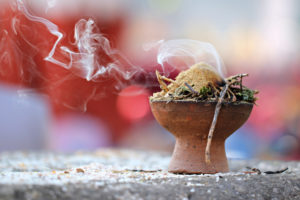
Since the dawn of time, humans have integrated aspects of the natural world into their spiritual beliefs and rituals. It’s unclear exactly who invented incense or why, but the art of combining fragrant plant-based materials and burning them for their scent has ancient roots. From ancient civilizations in the Middle East and Asia to modern Christians and pagans, its use spans multiple centuries and religious traditions throughout the world.
The Use of Incense in Antiquity
The Encyclopedia Britannica reveals that incense was burned in ancient Egypt during liturgies honoring Amun-Ra and mortuary rituals said to speed souls of the departed into the afterlife. One key benefit was its ability to obscure foul odors, but the tradition soon took on more spiritual meanings, with its adherents believing that the pleasant aromas were also enjoyed by their deities. The practice was also widespread in temple worship in both Babylon and Israel, and the ancient Greeks and Romans burned it in offerings to their gods and to protect themselves against demons. Later, the Romans used imported incense in both household worship and public rituals to honor their emperors.
Incense also played a part in Asian spiritual practices, possibly as early as 3000 B.C.E. Incense burners have been discovered in Bronze Age ruins located in central India, and scholars speculate that these Indus Valley cultures may have learned manufacturing techniques from their Chinese neighbors. It’s been a key component in Hindu and Buddhist practices, as well as in Shinto rituals and Chinese folk traditions. In those cultures, it was burned during public religious rites, to honor one’s ancestors, and to please the household gods.
Incense in Modern Christian and Pagan Practice
While the religious use of incense continues in Hindu, Buddhist, and other folk traditions throughout South and East Asia, some may be more familiar with its use in Christian contexts. The New World Encyclopedia explains that this aromatic substance is placed inside a metal censer and allowed to burn during Catholic, Lutheran, Anglican, and several Eastern Orthodox worship services. The person carrying the censer, sometimes called a “thurifer,” dispenses its smoke onto a desired person or object by swinging the censer in the appropriate direction.
Meanwhile, modern pagans have adopted incense into their personal and communal spiritual practices. Since Neopagan worship, rites, and beliefs systems can be complex, diverse, and eclectic, the specific methods and rationales for its use can also vary. Some typical reasons include the following:
- Focusing a practitioner’s intentions during rituals or spells
- Cleansing, purification, and healing
- Achieving specific outcomes such as protection, psychic power, or prosperity
- Consecration of ritual objects
- Honoring deities and presenting offerings to them
Witchipedia also points out that incense can stand in for the air element during rituals. Typically associated with the eastern cardinal direction, air has also come to represent mental processes and intellectual undertakings.
Pagans who want a steady supply of incense can easily source it from local shops or retailers online, but some choose to craft their own versions at home. Exemplore blogger Mackenzie Sage Wright describes the process for grinding roots, resins, woods, dried herbs, flowers, and spices with a mortar and pestle. The resulting powdery mixture can then be ignited on hot coals and burned inside a censer.
Secular Origins, Sacred Meanings?
Incense burning is a ubiquitous custom in many civilizations, but it’s easy to forget that the practice is a few thousand years old. It also may be another example of how the purpose of an object can be transformed from pure practicality to one with sacred meanings. While some rely on it to release pleasant fragrances inside their homes, it’s a frequent companion during private rituals and meditation as well as accompanying congregations in communal worship.

